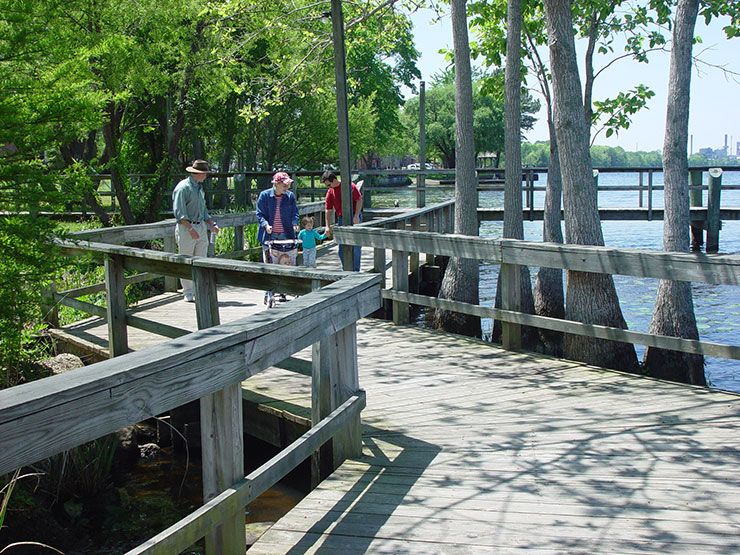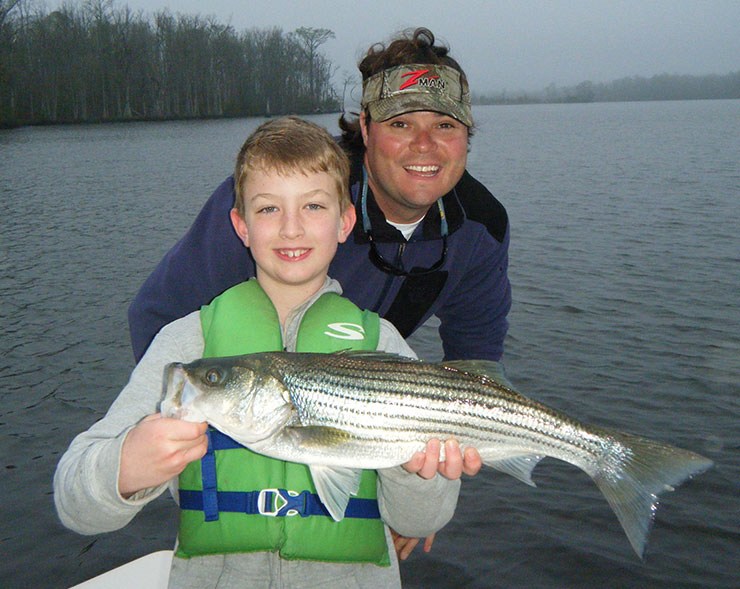PEOPLE AND PLACES: Awarding North Carolina Innovation

Six North Carolina graduate students are among the winners of the 2012 Walter B. Jones Sr. Awards, issued by the National Oceanic and Atmospheric Administration.
The Jones Awards for Excellence in Coastal and Marine Graduate Study recognize graduate students whose research “promises to contribute materially to the development of new or improved approaches to coastal or ocean management.”
The Town of Plymouth also is among the winners of a 2012 Jones Award for Coastal and Ocean Resource Management. Plymouth was selected for excellence in local government, along with communities from Florida, California and Oregon.
The awards, presented every other year, honor “the people and organizations of America for their dedication and outstanding contributions in helping the nation maintain healthy coastal and ocean resources and balance the needs of these resources with human use.”
The national awards are named for Walter B. Jones, Sr., who represented North Carolina in the U.S. House of Representatives from 1966 to 1992.
STUDENT ACHIEVERS
Ten graduate student awards are given nationally every other year. North Carolina Sea Grant provided research funding for four of the six North Carolina winners in 2012. Also, three of the graduate students are doing research within N.C. National Estuarine Research Reserve sites.
“The high number of North Carolina graduate students among the winners speaks to the excellent quality of marine and coastal research being conducted in our state, as well as to the caliber of the students themselves,” says Chris Brown, vice president for research and graduate education for the University of North Carolina System.
Michelle Brodeur is a doctoral student with Joel Fodrie in the Coastal Fisheries Oceanography and Ecology laboratory at the University of North Carolina at Chapel Hill’s Institute of Marine Sciences, or IMS. Previously a Sea Grant/N.C. National Estuarine Research Reserve fellow, she recently became a NOAA/NERRS fellow. Her research focuses on management of oyster reefs and how climate change will interact with stressors, such as eutrophication and nuisance algae. Brodeur’s work on the effect of algal mats on intertidal oysters in the Rachel Carson Reserve site was featured in the Summer 2011 issue of Coastwatch. “Michelle has become an industry unto herself,” Fodrie says, citing her expertise in the oyster reef ecosystem consisting of macroalgae, fishes and other animals.
“I really enjoy teaching the public about the habitats found in their backyards and hope to make my research — focusing on the processes that control where oyster reefs are found in the intertidal areas — accessible to the residents of North Carolina.” — Michelle Brodeur

• Michelle Covi is a doctoral candidate with Jennifer Brewer in the Coastal Resources Management program at East Carolina University. Covi also is outreach coordinator for the Renaissance Computing Institute’s East Carolina University Engagement Center, or RENCI at ECU. She is working with Donna Kain of the Technical and Professional Communications program at ECU on a Sea Grant-funded project evaluating risk communication and perception of sea-level rise in northeastern North Carolina. She also worked with a Sea Grant team that collaborated with Plymouth leaders to establish a strategy for addressing recurring flooding problems in the town. For her doctoral research, she is studying sea-level rise risk perception, communication and policy making in North Carolina. She is cited for her abilities to relate to local residents and use advanced techniques to analyze interview data. Covi authored an article for the Spring 2012 issue of Coastwatch on the Town of Plymouth and another article in this issue on hurricane risk communication.
“This work would not be possible without the support of Sea Grant, the ECU Coastal Resources Management program, RENCI at ECU and my mentors. I am pleased that our work engaging with the rural communities in our region to prepare for sea-level rise has received this recognition.” — Michelle Covi
• Jennifer Cudney-Burch is a doctoral student with Roger Rulifson at the Institute for Coastal Science and Policy at ECU. She was previously a National Sea Grant Knauss Fellow in the Highly Migratory Species Management Division of NOAA’s National Marine Fisheries Service. As a Knauss Fellow, she made a valuable connection between fishermen and policy makers. Her dissertation research addresses spiny dogfish management along the U.S. East Coast and Canada. Funded by the N.C. Fishery Resource Grant Program, Cudney-Burch’s study of spiny dogfish migration resulted in a new paradigm in spiny dogfish management plans being recognized at national and international levels. An article in the Summer 2010 issue of Coastwatch highlighted her use of acoustics to track fish movement.
“I am researching the migration and movement patterns of spiny dogfish in collaboration with the North Carolina Outer Banks fishing community. I think that working with the commercial fishermen was probably the best and most educational part of my graduate education to date.” — Jennifer Cudney-Burch

• Timothy Ellis is a doctoral student with Jeffrey Buckel and Joseph Hightower in North Carolina State University’s Fisheries, Wildlife and Conservation Biology program. His research, funded initially by FRG and later by the N.C. Coastal Recreational Fishing License Program, or CRFL, has resulted in significant contributions to the management of spotted sea trout. He is a scientific advisor on the N.C. Marine Fisheries Commission’s fisheries management plan advisory committee for spotted seatrout. His research was featured in the Spring 2009 issue of Coastwatch, in articles in The News & Observer of Raleigh and several other publications. Ellis was previously an N.C. Division of Marine Fisheries/Sea Grant fellow with Buckel. He is cited for his outreach to the fishing community and state management agencies.
“Being able to study difficult questions about a popular and important fishery in our state has been a very rewarding experience for me. It’s nice to be recognized for my efforts and I hope this award signifies that I’ve been doing the right thing.” — Timothy Ellis
• Rachel Gittman is a doctoral student with Charles Peterson and John Bruno in the Curriculum for the Environment and Ecology of UNC’s IMS. She has a NOAA/NERRS Graduate Research Fellowship to assess the ecological effects of shoreline stabilization on coastal resources, communities and habitats. Her work also is funded through a CRFL grant. Gittman is cited for her poise in environmental agency working groups and stakeholder meetings with citizens. Her work is helping advance the goals of the Coastal Zone Management Act by providing federal and state agencies with valuable data. Gittman was recently featured in an N.C. Coastal Federation article on the use of oyster shells as marsh sills.

I am evaluating the ability of alternative shoreline-stabilization techniques to maintain and enhance habitats. Shoreline stabilization using bulkheads and seawalls can degrade coastal habitats. Therefore, a better understanding of the success of other methods, such as marsh sills, is critical.” — Rachel Gittman
• Matthew McCarthy is pursuing a master’s of marine science with Joanne Halls, director of the Spatial Analysis lab in the Department of Geography and Geology at the University of North Carolina Wilmington. His research involves evaluation of new satellite imagery products and their usefulness for assessing habitat change in the coastal habitats of Masonboro Island, which is part of the N.C. National Estuarine Research Reserve. McCarthy won the 2011 G. Herbert Stout Award for the most innovative student paper from the N.C. GIS Conference and also the Hydrographic Society of America’s national 2012–13 scholarship. He is cited for undertaking a variety of new techniques that will result in a better understanding of the measurement of barrier island dynamics.
“I am excited that my results may improve and streamline future coastal habitat mapping efforts. I hope that the new methods will be adopted by coastal management organizations to better monitor our coasts with greater frequency and lower costs.” — Matthew McCarthy
THE TOWN OF PLYMOUTH
Sea Grant nominated Plymouth for its efforts to identify opportunities for economic growth while maintaining the environmental quality and diversity in the Lower Roanoke River Basin, which has been called the state’s environmental “crown jewel.”
“This is an incredible honor and recognition of our vision and journey in Plymouth. It reflects the enduring dedication and hard work of many great citizen volunteers, several outstanding community organizations and the leadership of our town officials,” Mayor Brian Roth notes.
Roth adds that the town is blessed with an amazing river delta teaming with wildlife and spectacular beauty. “It is our responsibility to be the best stewards we can be of this great gift, while continuing to promote our local businesses and our community,” he says.
The leaders of Plymouth seek to maintain the health of — and everyone’s ability to appreciate — the Roanoke River. Citizens and visitors enjoy the walkable historic and business district, a kayak-launch point, and a series of camping areas. Plymouth is an integral part of North Carolina’s birding and paddling trails, and hosts fishing tournaments and boat races.
The town also participated in the 2010 National Sea Grant Coastal Communities Climate Adaptation Initiative, part of a $1.2 million national program to help communities cope with short- and long-term impacts, from tropical storms to sea-level issues. Town leaders worked with Sea Grant extension specialists and researchers at RENCI to develop maps that predict areas prone to flooding.
“Plymouth is considered a national leader. Other communities are learning from Plymouth’s efforts to identify immediate needs, survive storms and significant hurricanes, and be prepared into the future,” Michael Voiland, Sea Grant executive director, comments.
The town’s plan to cope with water rise was featured in the Spring 2012 issue of Coastwatch.
See the full list of Jones Awards winners at: oceanservice.noaa.gov/jones-noaa-awards.html.
Read Facing the Future in Plymouth, NC: Preparing for Increased Flood Risks, at: ncseagrant.org/s/plymouth-rep.
This article was published in the Autumn 2012 issue of Coastwatch.
For contact information and reprint requests, visit ncseagrant.ncsu.edu/coastwatch/contact/.


